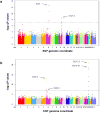Genome-wide association studies identify loci associated with age at menarche and age at natural menopause
- PMID: 19448621
- PMCID: PMC2888798
- DOI: 10.1038/ng.385
Genome-wide association studies identify loci associated with age at menarche and age at natural menopause
Abstract
Age at menarche and age at natural menopause are associated with causes of substantial morbidity and mortality such as breast cancer and cardiovascular disease. We conducted a joint analysis of two genome-wide association studies of these two traits in a total of 17,438 women from the Nurses' Health Study (NHS, N = 2,287) and the Women's Genome Health Study (WGHS, N = 15,151). For age at menarche, we identified ten associated SNPs (P = 1 × 10(-7)-3 × 10(-13)) clustered at 6q21 (in or near the gene LIN28B) and 9q31.2 (in an intergenic region). For age at natural menopause, we identified 13 associated SNPs (P = 1 × 10(-7)-1 × 10(-21)) clustered at 20p12.3 (in the gene MCM8), 19q13.42 (in or near the gene BRSK1), 5q35.2 (in or near genes UIMC1 and HK3) and 6p24.2 (in the gene SYCP2L). These newly identified loci might expand understanding of the biological pathways regulating these two traits.
Figures




Comment in
-
Genetics of reproductive lifespan.Nat Genet. 2009 Jun;41(6):637-8. doi: 10.1038/ng0609-637. Nat Genet. 2009. PMID: 19471299 No abstract available.
References
-
- Kvale G. Reproductive factors in breast cancer epidemiology. Acta Oncol. 1992;31:187–94. - PubMed
-
- Kaaks R, Lukanova A, Kurzer MS. Obesity, endogenous hormones, and endometrial cancer risk: a synthetic review. Cancer Epidemiol Biomarkers Prev. 2002;11:1531–43. - PubMed
-
- Paganini-Hill A, et al. Menstrual and reproductive factors and fracture risk: the Leisure World Cohort Study. J Womens Health (Larchmt) 2005;14:808–19. - PubMed
-
- te Velde ER, Pearson PL. The variability of female reproductive ageing. Hum Reprod Update. 2002;8:141–54. - PubMed
Publication types
MeSH terms
Grants and funding
LinkOut - more resources
Full Text Sources
Other Literature Sources
Medical
Molecular Biology Databases

